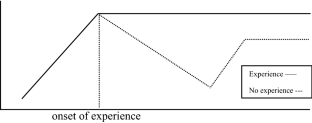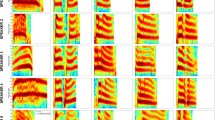Abstract
Several speech models have been formed in the past aiming to predict the abilities of nonnative listeners or learners in perceiving and producing speech sounds. The present paper proposes a new model for speech perception, the Universal Perceptual Model of Second Language (henceforth, UPM). UPM assumes that second language phone acquisition is strongly affected by the speakers’ native language but still the window of phone learning is open due to the universality of speech sounds. Also, it supports that second language phones are initially activated as disoriented phonetic units. In this paper, we provide some initial insights into the predictability of the model. UPM uses degrees of overlap and chance criteria to form its predictions. We recruited Cypriot Greek novice learners of Italian who participated in two psychoacoustic tasks in which they classified and discriminated Italian vowels, respectively. The findings demonstrated that the degree of overlap between two nonnative phones may be a good predictor of the speakers’ discrimination accuracy over these phones. UPM might be a useful model which aims to better explain speech perception mechanisms and patterns of speech acquisition.




Similar content being viewed by others
Change history
04 April 2022
A Correction to this paper has been published: https://doi.org/10.1007/s10339-022-01083-4
References
Abu-Rabia S, Kehat S (2004) The critical period for second language pronunciation: is there such a thing? Educational Psychol 24:77–97
Alispahic S, Mulak KE, Escudero P (2017) Acoustic properties predict perception of unfamiliar Dutch vowels by adult Australian English and Peruvian Spanish listeners. Front Psychol 8:52
Antoniou M, Tyler MD, Best CT (2012) Two ways to listen: Do L2-dominant bilinguals perceive stop voicing according to language mode? J Phon 40:582–594
Antoniou M (2010) One head, two languages: speech production and perception in Greek–English bilinguals, Doctoral dissertation, University of Western Sydney
Aoyama K, Flege JE (2011) Effects of L2 experience on perception of English /r/ and /l/ by native Japanese speakers. J Phon Soc Japan, 15, 5–13. [Copyright holder: The Phonetic Society of Japan]
Aslin RN, Pisoni DB (1980) Some developmental processes in speech perception. In: Yeni-Komshian GH, Kavanagh JF, Ferguson CA (eds) Child phonology: vol 2. Perception, New York: Academic Press
Aslin RN, Werker JF, Morgan JL (2002) Innate phonetic boundaries revisited (L). J Acous Soc Am 112:1257–1260
Baker W, Trofimovich P, Flege JE, Mack M, Halter R (2008) Child–adult differences in second-language phonological learning: the role of cross-language similarity. Lang Speech 51(4):317–342
Best CT, McRoberts GW (2003) Infant perception of non-native consonant contrasts that adults assimilate in different ways. Lang Speech 46:183–216
Best CT (1994) The emergence of native-language phonological influences in infants: A perceptual assimilation model. In: Goodman J, Nusbaum HC (eds) The development of speech perception: The transition from speech sounds to spoken words. MIT Press, Cambridge, MA, pp 167–224
Best CT (1995) A direct realist view of cross-language speech perception: New Directions in Research and Theory. In: Strange W (ed) Speech perception and linguistic experience: theoretical and methodological issues. York Press, Baltimore, pp 171–204
Best CT, Tyler M (2007) Non-native and second-language speech perception: commonalities and complementarities. In: Bohn OS, Munro MJ (eds) Second language speech learning: In honor of James Emil Flege, Amsterdam/Philadelphia, John Benjamins, pp 13–34
Boersma P, Weenink D (2020) Praat: doing phonetics by computer [Computer program]. Retrieved from http://www.fon.hum.uva.nl/praat/
Elvin J, Escudero P, Vasiliev P (2014) Spanish is better than English for discriminating Portuguese vowels: acoustic similarity versus vowel inventory. Frontiers in Psychology 5:1188
Escudero P (2005) linguistic perception and second language acquisition: explaining the attainment of optimal phonological categorization, Doctoral dissertation, Utrecht University
Escudero P (2009) Linguistic Perception of “similar” L2 sounds. In: Boersma P, Hamann S (eds) Phonology in Perception. Mouton de Gruyter, Berlin, pp 151–190
Escudero P, Boersma P (2004) Bridging the gap between L2 speech perception research and phonological theory. Stud Sec Lang Acq 26:551–585
Escudero P, Sisinni B, Grimaldi M (2014) The effect of vowel inventory and acoustic properties in Salento Italian learners of Southern British English vowels. J Acoust Soc Am 135:1577–1584
Faris MM, Best CT, Tyler MD (2016) An examination of the different ways that non-native phones may be perceptually assimilated as uncategorized. J Acoust Soc Am, 139(1):EL1–EL5
Faris MM, Best CT, Tyler MD (2018) Discrimination of uncategorised non-native vowel contrasts is modulated by perceived overlap with native phonological categories. J Phon 70:1–19
Flege J, MacKay I (2004) Perceiving vowels in a second language. Stud Sec Lang Acq 26:1–34
Flege J, Munro M, MacKay I (1995) The effect of age of second language learning on the production of English consonants. Speech Commun 16:1–26
Fowler CA (1986) An event approach to the study of speech perception from a direct-realist perspective. J Phon 14(1):3–28
Georgiou GP (2018) Discrimination of L2 Greek vowel contrasts: evidence from learners with Arabic L1 background. Speech Commun 102:68–77
Georgiou GP (2019a) ‘Bit’ and ‘beat’ are heard as the same: mapping the vowel perceptual patterns of Greek-English bilingual children. Lang Sci 72:1–12
Georgiou GP (2019b) Cue-reliance and vowel perceptual patterns of Cypriot Greek children who learn English. J Exp Phon 28:229–253
Georgiou GP (2020) Discrimination of Uncategorized-Categorized and Uncategorized-Uncategorized Greek consonantal contrasts by Russian speakers. Top Linguist 21(1):74–82
Georgiou GP (2021) Effects of Phonetic Training on the Discrimination of Second Language Sounds by Learners with Naturalistic Access to the Second Language. J Psycholinguist Res. https://doi.org/10.1007/s10936-021-09774-3
Georgiou GP, Themistocleous, C (2020) Vowel learning in diglossic settings: Evidence from Arabic-Greek learners. Int J Bilingualism 1–16 https://doi.org/10.1177/1367006920945396
Georgiou GP, Perfilieva N, Denisenko V, Novospasskaya N (2020a) Perceptual realization of Greek consonants by Russian monolingual speakers. Speech Commun 125:7–14
Georgiou GP, Perfilieva N, Tenizi M (2020b) Vocabulary size leads to a better attunement to L2 phonetic differences: clues from Russian learners of English. Lang Learn Dev 16(4):382–398
Guion SG, Flege JE, Akahane-Yamada R, Pruitt JC (2000) An investigation of current models of second language speech perception: The case of Japanese adults’ perception of English consonants. J Acoust Soc Am 107:2711–2724
Højen A, Flege JE (2006) Early learners’ discrimination of second-language vowels. J Acoust Soc Am 119(5):3072–3084
Iverson P, Kuhl PK, Akahane-Yamada R, Diesch E, Tohkura Y, Kettermann A, andSiebert, C. (2003) A perceptual interference account of acquisition difficulties for non-native phonemes. Cognition 87:B47–B57
Kuhl PK, Stevens E, Hayashi A, Deguchi T, Kiritani S, Iverson P (2006) Infants show a facilitation effect for native language phonetic perception between 6 and 12 months. Dev Sci 9(2):F13–F21
Kuhl PK (2000) A new view of language acquisition. In: proceedings of the national academy of sciences colloquium, auditory neuroscience: development, transduction, and integration. Irvine, Arnold and Mabel Beckman Center, pp 11850–11857
Kuhl PK, Miller D (1978) Speech perception by the chinchilla: Identification functions for synthetic VOT stimuli. Journal of the Acoustical. Soc Am 63:905–917
Kuhl PK, Padden DM (1983) Enhanced discriminability at the phonetic boundaries for the voicing feature in macaques. Percept Psychophys 32:542–550
Kuznetsova A, Brockhoff PB, Christensen RHB, Jensen SP (2020) Tests in linear mixed effects models. R package version 3.1–2
Lalonde CE, Werker JF (1995) Cognitive influences on cross-language speech perception in infancy. Infant Behav Dev 18(4):459–475
Lenth R, Singmann H, Jonathon Love J, Buerkner P, Herve M (2020) Estimated Marginal Means, aka Least-Squares Means. R package version 3.2
Levy ES, Law FF, II. (2010) Production of French vowels by American-English learners of French: language experience, consonantal context, and the perception-production relationship. J Acoust Soc Am 128:1290–1305
Polka L (1991) Cross-language speech perception in adults: phonemic, phonetic, and acoustic contributions. J Acoust Soc Am 89:2961–2977
Polka L (1992) Characterizing the influence of native language experience on adult speech perception. Percept Psychophys 52:37–52
Rogers D, d’ Arcangeli, L. (2004) Italian. J Int Phon Assoc 34(1):117–121
Streeter LA (1976) Language perception of two-month-old infants shows effects of both innate mechanisms and experience. Nature 250:39–41
Sun L, Van Heuven J (2007) Perceptual assimilation of English vowels by Chinese listeners. Can native-language interference be predicted? In: Los B, van Koppen M (eds) Linguistics in the Netherlands 2007, Amsterdam, John Benjamins, pp 150–161
Tsukada K, Birdsong D, Mack M, Sung H, Bialystok E, Flege JE (2004) Release bursts in English word-final voiceless stops produced by native English and Korean adults and children. Phonetica 61(2–3):67–83
Tyler MD, Best CT, Faber A, Levitt AG (2014) Perceptual assimilation and discrimination of non-native vowel contrasts. Phonetica 71(1):4–21
Van Leussen JW, Escudero P (2015) Learning to perceive and recognize a second language: The L2LP model revised. Front Psychol 6:1–12
Werker J, Tees R (1984) Cross-language speech perception: Evidence for perceptual reorganization during the first year of life. Infant Behav Dev 7(1):49–63
Werker JF (1995) Exploring developmental changes in cross-language speech perception. In: Gleitman LR, Liberman M (eds) An invitation to cognitive science. Language: An invitation to cognitive science, The MIT Press, Cambridge, p 87–106
Werker JF, Pegg JE (1992) Infant speech perception and phonological acquisition. In: Ferguson LMC, Stoel-Gammon C (eds) Phonological development: Models, research, and implications, York, Parkton, MD.
Author information
Authors and Affiliations
Corresponding author
Ethics declarations
Conflict of interest
We have no conflicts of interest to disclose.
Research involving Human Participants and/or Animals
Our research required the participation of adults in language forced-choice identification and discrimination tests.
Informed consent
The subjects were provided with written information with respect to their participation to the language experiments. They gave their written consent to participate, according to the Declaration of Helsinki
Additional information
Publisher's Note
Springer Nature remains neutral with regard to jurisdictional claims in published maps and institutional affiliations.
Handling editor: Gladys Nyarko Ansah (University of Ghana, Accra); Reviewers: Elizabeth Orfson-Offei (University of Ghana, Accra) and a second reviewer who prefers to remain anonymous.
Rights and permissions
About this article
Cite this article
Georgiou, G.P. Toward a new model for speech perception: the Universal Perceptual Model (UPM) of second language. Cogn Process 22, 277–289 (2021). https://doi.org/10.1007/s10339-021-01017-6
Received:
Accepted:
Published:
Issue Date:
DOI: https://doi.org/10.1007/s10339-021-01017-6




